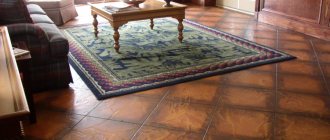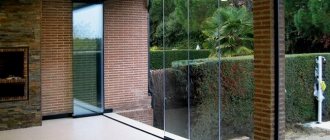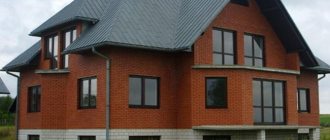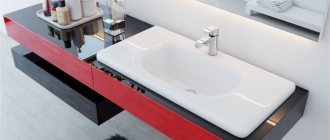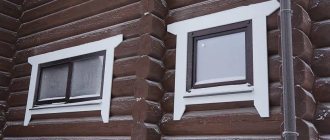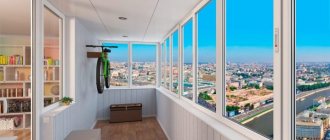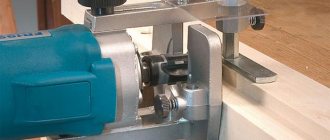At the same time, despite regulatory requirements, bright sun rays in the summer affect the comfort of people living or working indoors.
To reduce the intensity of ultraviolet radiation, films are used on windows to protect from the sun.
What it is?
Athermal (sun protection) films for windows are a thin polymer material on a self-adhesive base , which contains metal molecules designed to reflect ultraviolet rays.
This film is glued to the translucent part of the window structure on the interior side and prevents the penetration of most sunlight into the room, which eliminates excessive heating of furniture and finishing elements of the space being used.
Purposes of application
Solar control films glued to double-glazed windows allow you to achieve the following results :
Normalization of indoor temperature due to a significant reduction in ultraviolet radiation.- Eliminating the negative impact on curtains and other colored objects that gradually lose pigmentation.
- Increasing comfort when using the room, since bright light irritates the eyes and contributes to overheating of human skin.
- Reducing the intensity of evaporation from wet objects.
Before purchasing a film, you need to study the quality certificate of the product, which indicates the light transmittance as a percentage, which determines the degree of darkening of the room.
When and where is it suitable for darkening?
Athermal window film is suitable for the following types of translucent structures :
- Stained glass glazing of business and shopping centers.
- Glass domed roofs of spectacular real estate projects that involve large crowds of people.
- Indoor swimming pools, water parks equipped with floodlights.
- Cardio zones of fitness centers with improved views.
- Airport premises, which are almost always constructed with a large amount of façade glazing.
- Panoramic and standard window designs in residential buildings and apartments, provided that they are oriented to the south.
At the same time, for some buildings and structures, this method of sun protection is not used :
- Window structures oriented to the north, which completely eliminates insolation of premises in the central zone of the Russian Federation.
- In rooms with special requirements for ensuring the technological process.
- In schools, kindergartens, hospitals, rehabilitation centers and other public buildings, the amount of sunlight for which is determined by mandatory compliance with insolation standards.
- For any window units, if the installation of tinting films negatively affects the visual characteristics of the facades, which is especially important for buildings that are classified as architectural monuments or cultural heritage sites.
Before installing athermal films in the premises of apartments of business class residential buildings, or provided that the windows overlook busy city streets, it is recommended to obtain approval for changing the architectural appearance of the facade.
Types of films for window tinting
If we've already got down to business, let's learn the theory. The idea itself came rather from cars. And although the glass surfaces of skyscrapers are actively tinted in the United States, the greatest demands are placed on the road.
The Pilkingtons were the first to perfect the alloy glass casting method. In 1947, the melt began to pour onto liquid tin, which is where, we think, the idea of making k-glass came from. After another 12 years, the technological process was made public (by the Pilkingtons), as a result the whole world saw new prospects in obtaining high-quality glass.
And in the early sixties, the first film based on gold and polyamide appeared, which reflected the sun where the laws of optics indicate, as if a mirror had been inserted into the frame.
More on the topic Accessories for PVC windows and doors
Manufacturing companies multiplied like mushrooms while the Beatles gave their final public concerts. In 1966, the 3M company began producing window films.
But the idea behind k-glass is different. If, when making glass, a melt of tin IV oxide is added to the bath, the glass acquires completely new properties, beginning to reflect radiant energy. As you can easily see, in 1947 it was proposed to pour molten glass into liquid tin. Well, then we thought of adding more on top... so it turned out to be k-glass. The distribution of liquid in the bathroom was carried out according to the density of the substances.
Apparently it’s not difficult to guess that soon the idea came to mind not to solder the layer, but to stick it on. The point is that everyone could thus modify their window properly.
This is how the idea of a polyamide film interspersed with gold was born. As they say, everything new is well forgotten old. And the new idea exactly repeated the meaning of the mirror. It is known that in it a continuous layer of conductive metal is applied to the back side of the glass.
Over time, the technology has improved and simplified, and we have been able to modernize glass at home. And this is thanks to a self-adhesive film with an anti-adhesive layer on top of the adhesive composition. Toning is far from the only purpose; they also distinguish:
- Anti-vandal films that protect the package. The thickness of the polymer layer here is from 115 to 600 microns, which is much thicker than tinting. As a result of using such films, a thief cannot get inside. More precisely, the hacking time increases greatly. The polymer layer is very durable.
- Energy-saving films repeat the idea of k-glass and allow you to retain heat in the room. The lion's share of radiant energy is reflected back into the room.
Tint films are relatively thin and reflect sunlight onto the street. A good option would be to stick a car one on the windows for the following reason: the standard stipulates that the transmission capacity of the windshield in the visible spectrum should not be lower than 75%.
But most manufacturers exceed this parameter (many countries have similar legislation) and produce films with a throughput of at least 80%. And given the simple fact that a car can be used in a variety of weather conditions, we can conclude that such products are also suitable for home use.
I was attracted to the car film because it has heat-shrinkable properties. Using a heat gun, it can be molded to fit any frame shape. Many homes have unusual windows, so car wrap is a good choice. In this case, there are two types of binders:
- Drying and gaining strength due to this, relatively soft.
- Water curable. This type of adhesive is strong, and its existence in nature explains why the most common liquid on the planet cannot be used as an installation solution. Soap suds are also bad because they leave streaks.
Technical characteristics of sun protection material
All athermal (sun protection) films for windows, widely available for sale, have the following technical characteristics :
The thickness of the material ranges from 50 to 350 microns, which entails different mechanical strength.- Roll width is usually from 500 to 1500 mm. If it is necessary to protect wide openings, the products must be joined together.
- The length of the material in a roll is from 3 to 30 m.
- Color and type of surface – mirror, monochrome, blue, burgundy, with a green tint.
- Light transmittance – from 95% to 15%.
- Reflective ability – from 7% to 50%.
- Light absorption – from 10% to 30%.
- Light delay coefficient – 0.4 – 0.8.
- The ability to provide protection from intense ultraviolet radiation is from 60% to 99%.
- Thermal energy retention – from 40% to 90%.
The above characteristics are assigned to materials based on full-scale tests after the production of a pilot batch of products at the plant. The indicators are recorded in a quality passport, a copy of which must be attached to each product.
Requirements
There are no regulatory requirements for thermal films for installation on window structures of civil buildings according to GOST. However, manufacturers of such products are guided by the requirements of GOST 32565-2013 “Safety glass for land transport”, which provides instructions regarding the parameters of sun protection tinting:
- The product must block at least 50% of harmful ultraviolet rays.
- Mechanical tensile strength.
- Reliability of the adhesive composition, which prevents delamination of the material.
- The transparency of the film after sticking to glass should be more than 90%, that is, the polymer product should not distort, which reduces the visual characteristics.
- Constant film thickness, which depends on the quality of workmanship.
- Durability – at least 5 years, subject to normal use.
- Washable, including using chemical cleaning agents.
- Wear resistance of the internal coating under mechanical influence.
There are no restrictions on the light transmittance of film mounted on the windows of apartments, offices or private residential buildings.
At the same time, in the Russian Federation there are such regulatory documents as SP 52.13330.2016 and SanPiN 2.2.1/2.1.1.1278-03, according to which requirements for natural lighting are imposed on residential and public premises. If the installation of athermal film entails a violation of these standards, the room ceases to meet the functional requirements for it.
Window tinting in the apartment
Window tinting for residential and commercial properties is becoming an increasingly popular way to protect against prying eyes and the elements.
In addition, this is a great opportunity to solve a number of other problems while spending a minimum of time and money.
The simplest and most popular way to tint windows is to paste double-glazed windows with special films. Moreover, there are several types of such films. So which one is best for home use, and which one is best used in an office? Let's try to figure it out.
Varieties
Several types of polymer products for sun protection windows are widely available, which differ in chemical composition, manufacturing technology and technical characteristics:
Metallized
The polymer product is subjected to metal spraying, the amount of which determines the light transmittance and reflectivity.
Advantages:
low cost;- wide range of shades, dimensions, thicknesses;
- suitable for residential premises;
- does not heat up in the sun, which eliminates the release of toxins.
Flaws:
- efficiency does not exceed 50% - 60% reflection of ultraviolet rays;
- in hot weather the room continues to heat up.
Scope of application:
- residential buildings;
- apartments;
- office buildings of class B, C and below.
Average prices: from 400 – 600 rubles. for 1 roll with a width of 0.5 m and a length of 20 m.
Tablecloths
High-tech products from an increased price category, metal spraying is applied through electrolysis, which contributes to the uniform distribution of particles over the plane of the film.
Advantages:
- reflective ability exceeds 90%;
- guarantee of UV protection;
- increased mechanical strength.
Flaws:
- high price;
- complexity of the device due to thick material;
- a small selection of products with low light reflectance.
Scope of application:
- class A office centers;
- business class houses with stained glass windows.
Average prices: from 600 – 700 rubles. for 1 roll 0.5 x 10 m.
Pattern-metalized
The most functional and expensive product, the metallized coating for which is produced using a combined method. The first layer is created through the exchange of ions during electrolysis, the second is a protective mechanical spraying.
Advantages:
- the highest class of ultraviolet protection – up to 98%;
- avoiding heating of the material itself.
Flaws:
- high production costs are reflected in the price;
- limited use of the product in residential buildings.
Scope of application:
- facilities for holding entertainment and cultural events;
- covering stained glass glazing of modern high-rise buildings of premium class.
Average prices:
- from 1100 rub. for 1 roll – 0.5 x 10 m;
- from 1700 rub. per roll 0.9 x 10 m.
Mirror
Special attention should be paid to mirror film, the production of which uses silver ions sprayed in a thin layer onto a polymer plane.
The thickness of such films starts from 60 microns. Presented on the market in a wide range, they contribute to the absorption of up to 80% of solar energy , and have an increased reflectance of UV rays - up to 97%.
Among the disadvantages is the risk of destructuring the mirror coating if cheap materials are purchased.
Considering that mirror polymer films belong to the class of metallized products, their cost does not exceed 500 - 700 rubles. for 1 roll with a length of up to 20 m.
Peculiarities
Soft transparent windows for verandas and balconies have come into use relatively recently, but have already proven their ease of use. They are called differently - silicone windows, PVC curtains, as well as transparent sheets. The relevance of the material is explained very simply - when going on vacation in nature, owners of country houses are forced to remember that the weather can turn bad at any moment.
Rain, hot rays of the sun, dust, gusty wind and, of course, the ubiquitous insects can interfere with a comfortable pastime. With the onset of autumn, the gazebos are filled with fallen leaves, and rainwater flows with mud penetrate there. In winter, such rooms are often covered with snow. All this has an adverse effect on the materials from which seasonal structures are built.
If you perform standard rigid glazing, then the cost of the enclosing structures will be quite high, especially if you use classic windows with plastic double-glazed windows.
It should be taken into account that ordinary durable polyethylene cannot be used in this case, since it turns into unsightly rags - the material can tear from a sharp wind, and becomes cloudy under the influence of UV rays.
To install soft windows, denser and more durable canvases with high technical and operational characteristics are usually used:
- service period - 5-10 years;
- strength - withstands the throw of a small stone or brick;
- light transmission - up to 85%;
- operating temperature range - from -30 to +60 degrees.
When used at elevated temperatures, the material does not emit toxic substances. The combination of these characteristics, combined with an affordable price, leads to the fact that the demand for plastic windows is steadily growing these days.
Tips for choosing
Considering the wide range of products in this category on the Russian market, making the right choice can be difficult. Before purchasing a product at a retail outlet, it is recommended to take into account a number of important nuances :
- Film thickness - experts do not recommend purchasing products with this parameter less than 80 microns, as it is easily damaged by any mechanical impact.
- Uniformity of composition - before purchasing, it is recommended to check the product against light - if stains or non-uniform areas are detected, you should refuse the purchase.
- No traces of defects - dents, foreign inclusions.
- The film should be smooth to the touch, the metallized coating should not peel off and remain on your hands.
- Each product must be accompanied by a quality passport indicating the state certificate number.
- When studying the chemical composition, the polymer should not contain formaldehyde and other toxins hazardous to health.
The most important selection criterion is brand recognition, the year the company was founded, marketing policy, as well as the presence of positive reviews from satisfied customers online.
The most famous manufacturer of table film in the world is the Japanese company Meiwa. They provide clear, colored, matte overlays to the market. , both in large rolls and in standard tabletop sizes.
In terms of their positive qualities, glass table films from domestic manufacturers do not lag behind Japanese ones. Decosave and Modern companies produce both transparent overlays and tablecloths in various shades and patterns, which allows you to match them to any interior.
“Ofiston” is considered the best company in Belarus that produces thick transparent film for the table. Their transparent tablecloths have gained popularity among customers, which indicates the high quality of the product.
Everyone has probably heard about the Swiss company Ikea. The quality of this company's products is evidenced by many positive reviews. The models of table films that are most quickly leaving the shelves of the Ikea store are the transparent “Preuss” and “Skrutt”.
The following companies are also successful in selling silicone tablecloths:
- Durable;
- Esselte;
- Leitz.
TOP best representatives
According to consumer reviews, the following brands are considered the best products for sun protection
- Madico, USA - average price 20 thousand rubles. for 1 roll with dimensions 1.5 x 30 m (45 m2).
- Velx, South Korea - average price 600 rubles. for 1 roll with dimensions 0.75 x 3 m (2.25 m2).
- USB, Taiwan - average price 1,500 rubles. for 1 roll 1.5 x 3 m (4.5 m2).
- DC-Fix, Germany - average price 2 thousand rubles. for 1 roll 0.9 x 2 m (1.8 m2).
- Scorpio, China - average price 6 thousand rubles. for 1 roll 0.75 x 30 m (22.5 m2).
The above TOP of the best athermal films is subjective, is advisory in nature and cannot be used as a direct indication for purchase.
Saint Petersburg
Office:
Address: 195220 St. Petersburg, Nepokorennykh Ave., building 49, lit. A Telephone fax: (812) 313-2-898 (multi-channel) Email
Shushary warehouse:
Address: St. Petersburg, Moskovskoe highway, building 161, building 10
Solntsevo Warehouse:
Address: Moscow, Proizvodstvennaya street, building 11 Solntsevo, 3 km from the Moscow Ring Road
Warehouse MO:
Address: Moscow region, Ramenisky district, Eganovo village.
Warehouse and loading, Russian Railways: Destination station: Oktyabrskaya railway. code: 037405 Abbreviated name: FSUE “SMU of the Ministry of Internal Affairs of Russia for St. Petersburg and the Leningrad Region” (8115) code: 08581096
Tools and accessories for installation
To install metallized or tablecloth films on windows, you will need the following set of tools and consumables :
Tape measure, ruler for taking measurements and marking material.- Scissors or a stationery knife for cutting film.
- Clean water at room temperature.
- Shampoo for creating an alkaline (soapy) environment.
- Container for diluting the solution.
- A brush with soft bristles for applying the solution to the glass surface.
- Spray bottle for spraying soap composition when installing the film.
- Rubber spatula for smoothing the product after gluing.
- A needle for removing small bubbles in case of detection of defects during installation.
All tools and materials must be of high quality, cleaned of dirt, sharpened and ready for work.
How to apply car tint to apartment windows
This film is more expensive, but it transmits light excellently.
To be more precise, good samples reflect 54% of the sun's radiation, while transmitting 80% of the visible spectrum. Your home will become noticeably cooler in the summer. There are two nuances in this case:
- It is better to glue the film using a special installation solution. This is necessary to even out the tint and eliminate streaks.
- Problem areas and arrows are simply treated carefully with a hair dryer. At the same time, the film begins to shrink, and all irregularities are eliminated. At the same time, the area is subjected to forcing.
Using a hair dryer, the tinting of the glass unit is removed. The glass is heated to approximately 45 degrees Celsius, after which you need to carefully lift the film from the edge and start removing it. The hair dryer follows the bend. Like the scales of a molting snake, the film will leave the surface of the glass.
Source: remvizor.ru
Step-by-step mounting instructions
To install a polymer film with a reflective effect on windows, you will need to consistently follow the following flow chart :
- The window is thoroughly washed and dried so that not a single stain or defect remains on the inner surface of the glass.
- The translucent surface of the glass is measured.
- The measurements taken are transferred to film.
- A piece of the required length is unwound from the roll.
- The product is cut out according to the markings.
- A solution is prepared in a container at the rate of 50 - 70 ml of shampoo per 1.5 liters of clean water.
- The liquid is evenly applied to the glass over the entire area.
- The protective layer is removed from the film.
- The product is applied to the glass in one of the corners.
- The film is evenly smoothed over the entire area of the translucent structure with a rubber spatula.
- At the final stage, the quality of fixation of the material is controlled, and, if necessary, air bubbles are removed from under the film.
After installing the film, the window should not be used in operating mode for 24 hours, which is required for complete polymerization of the alkaline environment and drying of the film on the glass.
Possible difficulties and errors
When installing an athermal film with their own hands, beginners can make a number of gross mistakes that will inevitably lead to a negative result. To prevent this from happening, experts recommend taking into account a number of nuances :
- The film has burrs on the edges - cutting should only be done with a well-sharpened knife along a ruler.
- After installing the product, hair or dust particles are found under its surface - the protective layer should be peeled off simultaneously with fixing the material to the glass.
- There are many bubbles under the film - after applying the soap solution to the surface of the glass, you must wait until all the foam settles and disappears.
- The film does not fit in size - when marking and cutting the material, it must be in a free state, without tension.
If you carefully follow the recommendations, the resulting translucent structure will operate for at least 5 - 7 years, without the need for restoration or replacement.
Caring for a Tinted Window
Glass tinted with film should not be washed during the first week after pasting, so as not to damage the coating.
In the future, when the film finally “lies” on the glass, you can care for the window as usual, avoiding only abrasive cleaning products, hard brushes and sponges.
If dirt has formed on the glass unit, there is no need to scrape it off. It is enough to moisten it with soapy water, and after a while simply remove it with a damp sponge. And then polish the surface with a soft, lint-free cloth.
Source: okeymaster.ru
General pros and cons of use
The use of athermal films for protecting rooms from the sun is growing every year, due to the presence of many advantages :
Effective protection of the room from excessive ultraviolet radiation.- Preservation of the visual characteristics of the translucent structure.
- Easy installation - installation of the material does not require contacting professionals, since all work can be done with your own hands.
- Allows you to preserve the original color of curtains, carpets, furniture, and decorative elements.
At the same time, despite the advantages, such products have several minor disadvantages :
- Subject to mechanical damage.
- High cost, in the presence of high-quality metallized coating.
- Reduces the level of insolation of premises.
- May peel off if installed incorrectly.
The above disadvantages are subjective and are often not taken into account by consumers, as a result of which the products always find their buyer.
User reviews
Many property owners leave a lot of positive and negative reviews about sun protection films on forums on the Internet:
- High efficiency of products in a higher price category.
- Any metallized film effectively absorbs light and shades the room.
- Low thermal energy absorption coefficient.
- If you have a glass roof, a film with a light absorption rate of more than 80% will save you from the summer heat.
- High cost of quality products.
You can read real consumer reviews here, here and here.
Average prices for sticker services
Many installation companies involved in the maintenance of residential and public premises offer services for gluing film to windows for sun protection. Given the high level of competition, prices for these services throughout the country are approximately the same :
Standard sticker for a metallized product – from 200 rub./m2.- Installation of film with joining on a panoramic window - from 300 rubles/m2.
- Sticker of material on an arched window - from 350 rub./m2.
- Installation of products on stained glass windows of business centers - from 250 rubles/m2.
- Installation of film on glass roofs of shopping centers, stadiums, swimming pools - from 400 rubles/m2.
- Discounts for volume – from 10% to 30%, provided the glazing area is from 100 to 300 m2.
The above prices depend on the following factors :
- Removing an object from the city.
- Number of window blocks.
- Glazing area.
- Quality of material.
- There are additional complications.
- The need to join the material in width.
- Urgency of work.
- Configuration of translucent structures.
- Internal pricing policy of the company.
The final cost of the service is determined by calculating the estimate, taking into account basic prices and increasing factors.
